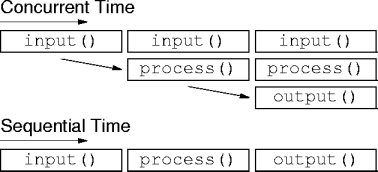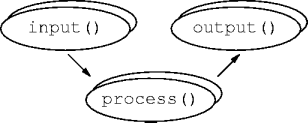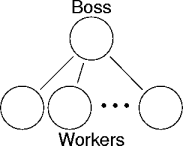- Easier design, with large grain and narrow interfaces.
- Better performance, with no waiting and overlapping execution.
- Increased reliability; failure isn't final; easy replication
Concurrency Design
- Concurrent computations allow for easier design, with large grain and narrow interfaces.
- Consider your basic read-process-write loop.
Sequential Concurrent loop output( process( input()))

- Each stage can be designed separately.
Concurrent Performance
- Concurrent computations can have better performance than sequential
computations.
- Concurrency eliminates waiting and overlaps execution.

Concurrent Reliability
- Concurrency provides increased reliability.
- Easy replication reduces the effects of failure

- If one process fails, replace it with a copy.
Concurrent Processing
- Concurrent computations happen "at the same time".
- Multiprocessing provides simulated concurrency.
- Computations seem to be occurring at the same time.
- Multiprocessors provide true concurrency.
- Computations are occurring at the same time.
Concurrent Architectures
- How are concurrent computations organized?
- Boss-worker.
- Symmetric coupling.
- Loosely coupling.
Boss-Worker Architectures
- The boss-worker architecture is straight-forward.

- Coordination is simple but possibly inefficient.
- Reliability is fair to poor.
- Performance is dependent on task